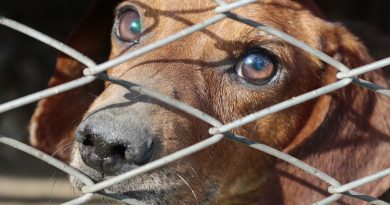Nearly Naked Body Painted Animal Advocates to Urge UBC to End Animal Experiments
Stop UBC Animal Research teams up with PETA to expose UBC
Braving predicted cool temperatures and rain, a menagerie of animal advocates – whose nearly nude bodies will be painted to resemble cats, monkeys, mice, and other animals tormented in laboratories at the University of British Columbia – will gather Sunday at the Vancouver Art Gallery to expose UBC’s cruel and lethal experiments on animals. The Vancouver-based Stop UBC Animal Research will team up with the world’s leading animal rights group, People for the Ethical Treatment of Animals (PETA), to stage a mock UBC animal experimentation laboratory where activists role playing as “mad scientists” will conduct “experiments” on the activists dressed as animals.
WHO: Stop UBC Animal Research and PETA
WHEN: Sunday, October 24, 12:30 PM
WHERE: Vancouver Art Gallery, 750 Hornby Street (Georgia Street side)
VISUALS: Nearly naked animal advocates body painted as animals in UBC’s laboratories; animal activists on operating table being experimented on and in restraint chair and cages; staged UBC laboratory including actual lab equipment such as operating table, ECT unit (disabled), IV stands; activists dressed as UBC experimenters; signs including “UBC Laboratory – Public Keep Out,” “Stop Cruel Animal Tests” “Stop UBC Animal Research.” Body painting provided by Vancouver business, Mehndi & More Body Art, which has created temporary face and body designs for major companies and institutions throughout the city.
WHY: UBC has an extensive animal experimentation program. Every year, the university conducts thousands of experiments on cats, mice, monkeys, pigs, rabbits, and other animals. Many of those experiments employ extremely painful and ultimately, lethal procedures. Nearly all of the experimentation is conducted with little public knowledge or scrutiny. One UBC experimenter, for example, has experimented on cats for 30 years. In 2008, he received a five-year, federally funded grant for continued animal experimentation. In his papers, the experimenter describes how he had cut open the backs of cats to expose their vertebrae, inserted titanium screws into the cats’ spinal columns to inhibit movement, and built restraint chambers around the cats’ exposed vertebra to give experimenters access to the cats’ spinal columns and to fix the animals in a sitting position for recording sessions. Other UBC experimenters have conducted experiments on and off campus in which they have: repeatedly poured saline solution into newborn piglets’ lungs to induce respiratory failure; captured wild songbirds in mist nets; withdrew their blood then decapitated the birds; continuously exposed mice to cigarette smoke in emphysema studies; and blinded monkeys in vision deprivation studies.
QUOTES: “Our momentary discomfort is nothing compared to what the animals endure on a daily basis at UBC,” said Stop UBC Animal Research activist, Annette Parkes, who braved the cold to strip down and pose as a cat used in research at UBC.
“Canadian taxpayers have unwittingly funded UBC’s cruel and crude experiments and they deserve to know the truth about the treatment of animals inside UBC’s laboratories,” said Alka Chandna from PETA. “Yet, the university has refused to release vital information about experiments in which monkeys were subjected to electroconvulsive shock treatment and kittens were raised in darkness to conduct vision experiments.”

